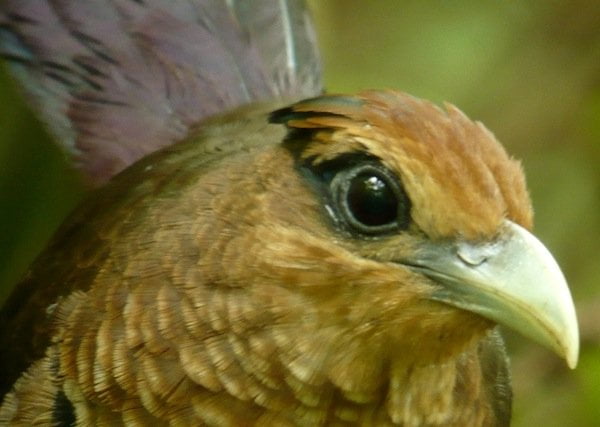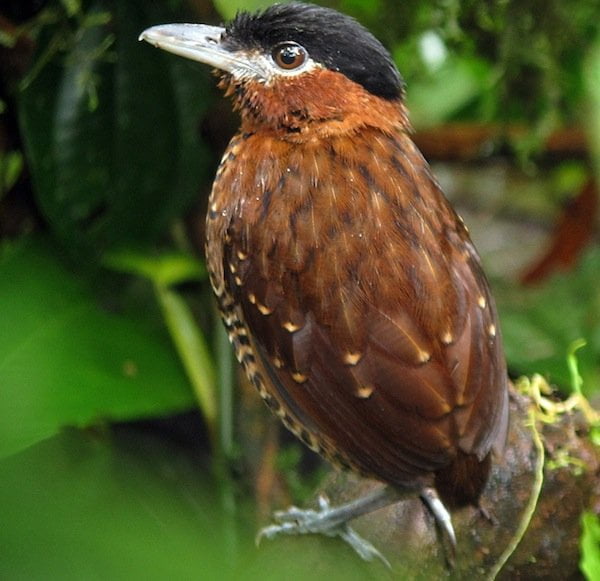The Nikon’s BATV crew headed down to Panama to hunt for antbirds in February 2009. We were hosted by the wonderful staff at the Canopy Tower and Canopy Lodge – excellent bases from which to explore the surrounding areas for antbird and antpitta species. If you want to find various antbird species in the Neo-tropics a good place to start is a swarm of army ants. The lives of many of the antbird species are so inextricably tied to ants that its important to understand the dynamics of ant swarms.
There are over 200 species of army ants and, contrary to popular belief, antbirds do not follow ant swarms to feast on the ants themselves. You see, army ants have a formic acid jelly center that does not taste very good. Instead antbirds prey on the insects disturbed by the ants. As a side-note it must be said that the same rule does not apply to the relationship between Cattle Egrets and cattle – at least to my videographer, Aderman. He assures me that Cattle Egrets do in fact prey on cattle and not insects. Apparently he witnessed a successful Cattle Egret hunt once, near Lake Okeechobee in Florida. About 50 birds took down an adult cow. It was his birthday and he had been drinking.
In Panama and other countries in the Neo-tropics one of the most frequently followed species of army ants is eciton burchelli. This ant has a temporary nest or bivouac, identified by a dense ball of ants. Sitting and watching a stationary bivouac in anticipation of antbirds will bring little success. Kinda like sitting and watching the Dolphins in anticipation of a Super Bowl win. One needs to wait until the ants head out in a single column to begin the hunt. The single column then fans out into a massive hunting swarm, sometimes several meters in width, but all the while attached to the single column which is, in turn, attached to the bivouac. The swarming hunting fan is where one should look for antbirds. Whilst many species of antbirds frequently follow army ant swarms, there are less than 30 professional antbirds or ant specialists. Two of these professionals are the Bi-colored Antbird and the Spotted Antbird and where you find the two together you can be sure that an ant swarm is close by.
httpvh://www.youtube.com/watch?v=PMTNxs2jVN4
In Panama, another reason to follow ant swarms is the Rufous-vented Ground-cuckoo. This highly sought-after species is nearly impossible to find in the absence of ants. But finding a good swarm with a nice flock of antbirds in attendance is key to finding the ground-cuckoo.
 Rufous-vented Ground-cuckoo by Carlos Bethancourt
Rufous-vented Ground-cuckoo by Carlos Bethancourt
Probably the most common antpitta species around Canopy Tower is the Streak-chested Antpitta. The presence of this unassuming little bird is often betrayed by its far-reaching liquid call. The call is quite easy to replicate and with a bit of patience it can be lured close by…
httpvh://www.youtube.com/watch?v=3nLv8fZ-wAM
But the antpitta we most wanted to find on our trip to Panama was the rare and elusive Black-crowned Antpitta or Gnatpitta, a bird which can be frustratingly difficult to see, let alone get good footage of. My videographer, Aderman, hates antpittas with a passion seldom seen in non-birders. On several occasions since our Panama trip I have actually heard him referring to someone as a “Son of an Antpitta”. That’s when you know Aderman really does not like you at all. Thankfully, he has only called me that once and that was when I told him we would be filming antpittas for our upcoming series in Ecuador.
 Black-crowned Antpitta by Scott Olmstead
Black-crowned Antpitta by Scott Olmstead
To find Black-crowned Antpittas its best to hire a good local guide who, not only knows where to find the birds, but also knows their habits intimately. One such leader is the legendary Carlos Bethancourt of Canopy Tower. Carlos will tell you that the key to getting a glimpse of this really elusive species is patience – and lots of it. The bird – or pair of birds in our case – moves in a circuit around its territory and will often visit the same areas with each revolution. It is best to first observe which areas the birds seem to be favoring and then to sit and wait with a view of a mossy log or rock. These tend to be favorite “sentinel sites” of the birds and, with a bit of perseverance, you should be rewarded with a brief look as it hops up for a second or two and then runs off. It took us about 5 hours to get these three seconds of footage…
httpvh://www.youtube.com/watch?v=-ofR8E2htAQ
Head down to Panama and get your antbird fix. If you find and photograph a Black-crowned Antpitta in less than an hour write to me and I’ll send you a prize. Maybe.













Yet another awesome, entertaining, and exciting post from James Currie! Pretty amazing to show footage of such a mega cool and difficult to see species as Black-crowned Antpitta (Gnatpitta). We get a different subspecies in Costa Rica that has become more difficult to find in recent years. They occasionally turn up at antswarms but the Zen-like sit and wait approach described above is certainly the most reliable.
Sigh.
@Pat: “Awesome, entertaining, and exciting” is exactly right. I’m starting to think that inviting James onto the blog was a mistake as he constantly makes me jealous, envious, and any other synonym that means wishing I were him…
@Clare: What are you complaining about? You have the sun back again!
ya true
@Pat: Thanks Pat. Would love to see them in Costa Rica
@Corey: It’s really tough work mate, really tough! 🙂
Gripping yarn as usual, James. I saw the Black-crowned Antpitta at the Canopy Lodge too, same place where Scott Olmstead got that insane pic… clearly his looks were better than mine! As for the ground-cuckoo, that is a world-class bird.
@Mike: Yes I think Scott has the best pic of a BC Antpitta recorded to date! The Ground-cuckoo was actually supposed to be our Golden Bird for that particular show but we had no luck! Have to go back for that one…
Sorry about the Ground-Cuckoo, I know a good spot… the Black-crowned Antpitta is really a beautiful bird… not in vain we have it as our 600 Club’s logo down here in Panama!
This post coincides nicely with “Army Ant Week”, going on over at Alex Wild’s insect photography blog http://myrmecos.net/ .
One little thing – Army ants (subfamily Ecitoninae) do taste bad, but not because they have formic acid, a venom component limited to a different subfamily of ants (Formicinae). Army ants’ legginess, stings and secretion of skatole (notable fecal odor) are what make them distasteful.
@James: Nice work letting us know that James. Always good to learn a new fact. Thanks for contributing!
Hi, James: Thanks so much for this great post – love the videos…how can anyone not like Antpittas? That little Streak-chested one is so cute when he sings!
I will be visiting Canopy Tower and Lodge mid June and am furiously studying my Birds of Panama guide. All these birds are “Golden Birds” if you ask me! I have the I-Bird pro on my Ipod which I enjoy listening (and desperately trying to memorize) the bird songs. Do you know of anything for the Central American bird songs that can be loaded on the Ipod? I know we will have the fabulous guides, but I like to be able to identify the birds we see myself, not just be told what they are.
Thanks for all you do in the world of birding – Love your show! On birding trips, the first thing we say every morning is “Let’s Go Birding”!
@Peggy: Probably the bets resource for downloading bird songs is http://www.xeno-canto.org/. Although you need to download each song/species individually. It does help you learn the calls though! Good luck and enjoy!
Thanks, James.
I know of that website, but of course was hoping for an easier way! OK, looks like I have a lot of work to do!